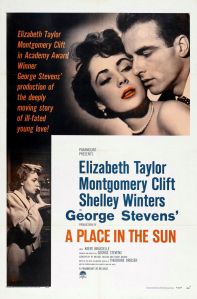Based on Theodore Dreiser’s An American Tragedy and the subsequent play by Patrick Kearney, A Place in the Sun (1951) owes much of its impact to director George Stevens and his uncanny casting. For the lead, George Eastman, he honed in on Montgomery Clift and the magnetic young actor proved to be a perfect fit for the humble, poor George whose wealthy Uncle Charles (Herbert Heyes) lures him to the big city with the promise of an entry level job to kick-start his fortunes. George initially falls for the first co-worker who shows an interest: Alice Tripp (Shelley Winters in an impressively deglamourized role) seems like the girl of his dreams: honest, decent, and dependable. The flip side of the coin is glamorous young socialite Angela Vickers (Elizabeth Taylor, in her first serious adult role at 17), who exudes class and acts as an alluring, sensual counterpoint. Seemingly untouchable, Angela doesn’t even register George’s presence the first time they’re in a room full of people together, but as he climbs the first rung of his uncle’s company, their paths fatefully cross again. Despite the rock solid presence of Alice in his life, the temptation of the privileged Angela and the lifestyle that comes with her is too potent and George, intoxicated by the possibilities, begins a double life that will inevitably bring inescapable complications and an intractable weight down upon his conscience.
So many moments scattered throughout A Place in the Sun are used for portentous or symbolic purposes: the eerie call of a loon, the wind whipped trees outside a window in which a still Angela is framed; the recounting of a tragedy that will be echoed, fatefully, later on. These and more, each one brilliantly weighted and executed by Stevens, underline the discordant notes that are powerfully reflected upon Clift’s remarkably expressive, tortured face. As George slowly suffocates from the increasingly irrational, jealous Alice, Stevens often closes in uncomfortably; we see a visage racked with the burden of tortured thoughts, sinister motives and potential outcomes. On a boat with Alice, vainly attempting to create an illusion of life moving on, troubles painfully but necessarily tucked away, we watch George squirm, awkwardly resting against the side of the stifling, inadequate vessel. The water closes in, his forehead swims in sweat. Clift’s nerve in allowing body language and non-verbal communication to foreshadow doom remains a masterclass in method acting. At the same time, Michael Wilson and Harry Brown’s screenplay continues to underscore the deeper psychological roots festering beneath the surface.
The film exquisitely explores the conflict of inner and external forces as well as how the yearning to exceed our origins, to delve outside of our comfort zone, as in climbing social strata, can be like playing with dynamite. For George there is the holy temptation of a beautiful woman who can elevate him but, with a devolving glance back at the past rushing to catch up with him, blow him sky high. A Place in the Sun remains a remarkable piece of cinema, brilliantly directed by Stevens, and performed by all three leads. The chemistry between Clift and Taylor is obvious with the pair becoming lifelong friends and influential in each other’s career. The film also features a remarkable, psychologically probing score from Franz Waxman whose best work from the Golden era of Hollywood filmmaking stacks up with any of the other great composers beyond Herrmann and Rozsa.
